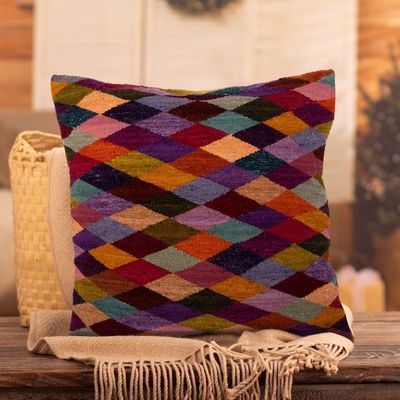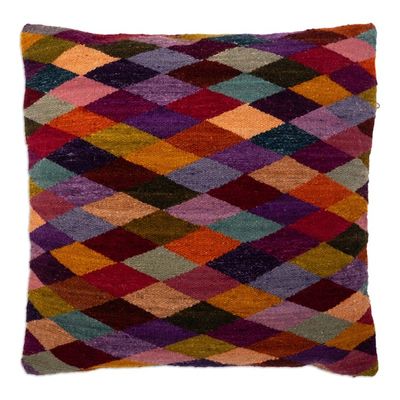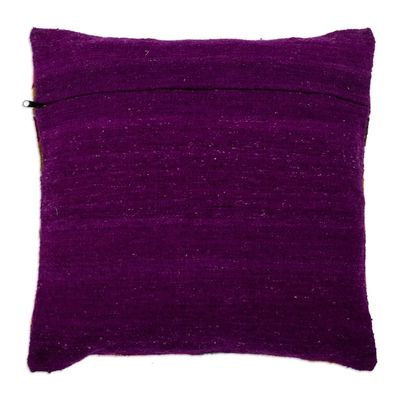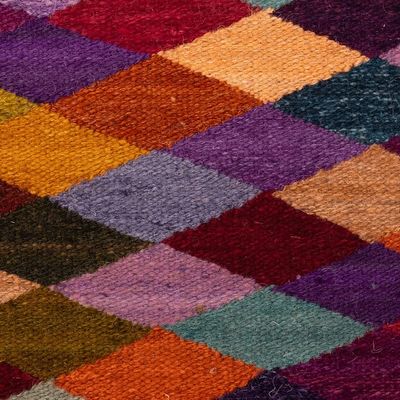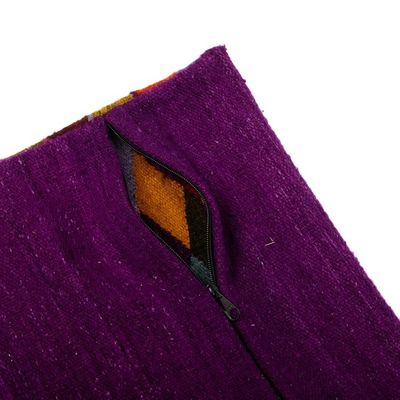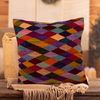Facilitated by
The Andes Fulfillment Hub

Gerardo Fernandez hand-loomed wool rugs
“One of the hardest and most difficult moments that happened was in the 80’s as a result of the terrorism that affected our economy. It especially impacted the tourism and trade sector, since the Department of Ayacucho was an area very affected by social conflicts (terrorism); and I was forced to go out to find new markets in other locations because my work meant family support. Our economic recovery was very slow, but with our courage and effort to move forward, we have kept working until today, maintaining our art legacy in the family and promoting the textile culture of Ayacucho.
“What attracts me to this art is developing my creativity; it keeps me in constant activity throughout the process, from the selection of wool, dyeing, elaboration and selection of the design, the combination of colors--it is a very attractive world for anyone passionate about art. I take inspiration from designs and geoglyphs of our pre-Inca cultures, such as the Wari culture and the Paracas culture. I also take as inspiration from the trends of colors and modern designs.
“The most challenging thing that I find is to keep innovating and adapting to the demands of the market. I want to be innovative without losing the essence of Ayacucho weaving, handmade on artisanal looms. It is also a challenge to work with 100% natural materials, keeping our raw material such as sheep wool and alpaca, hand-spun and dyed with the pigments of natural plants. It is important to maintain the quality of the finish of our works, despite the high competition of low-quality works made with synthetic materials.
“I work with my children. We organize ourselves by delegating each part of the process to facilitate and speed up the progress. My wife is in charge of collecting the raw material such as sheep wool; my children are in charge of preparing the skeins for dyeing; and I am charged with dyeing and designing the work to be carried out on the loom.
“I provide support and inspiration to young people and adults who are undertaking in the Ayacucho textile art. One of the great benefits of my workshop is that I focus on training young migrants from towns far from the city, who for study or work reasons, come to my workshop. Here they can learn this art, and perhaps have an economic livelihood creating their own pieces. I am hopeful in my dreams and future plans to be able to exhibit my work in art galleries abroad. My dream is that my grandchildren continue with the legacy of this art and that it lasts. I am very grateful to be part of the Novica family."

Gerardo Fernandez
“I was born in 1960 in the legendary town of Huamanga, Ayacucho; the cradle of famous artisans for the magnificence of their tapestries. I became interested in this beautiful art thanks to my grandparents and parents, who dedicated themselves to preparing the materials to carry out the work on the looms. As a teenager, I took on the responsibility of starting with the loom business to be able to support my parents with their livelihood. To learn and acquire mastery in this art it took constant practice, dedication and a love of textile arts that I deliver when doing each job. I started working independently at the age of 17, taking my work to different places such as Cuzco, Lima, and Arequipa. I participated in different craft fairs, which was a bit challenging at first as you have to expose your work and be liked by the tourists or clients who acquire our textile art.
“One of the hardest and most difficult moments that happened was in the 80’s as a result of the terrorism that affected our economy. It especially impacted the tourism and trade sector, since the Department of Ayacucho was an area very affected by social conflicts (terrorism); and I was forced to go out to find new markets in other locations because my work meant family support. Our economic recovery was very slow, but with our courage and effort to move forward, we have kept working until today, maintaining our art legacy in the family and promoting the textile culture of Ayacucho.
“What attracts me to this art is developing my creativity; it keeps me in constant activity throughout the process, from the selection of wool, dyeing, elaboration and selection of the design, the combination of colors--it is a very attractive world for anyone passionate about art. I take inspiration from designs and geoglyphs of our pre-Inca cultures, such as the Wari culture and the Paracas culture. I also take as inspiration from the trends of colors and modern designs.
“The most challenging thing that I find is to keep innovating and adapting to the demands of the market. I want to be innovative without losing the essence of Ayacucho weaving, handmade on artisanal looms. It is also a challenge to work with 100% natural materials, keeping our raw material such as sheep wool and alpaca, hand-spun and dyed with the pigments of natural plants. It is important to maintain the quality of the finish of our works, despite the high competition of low-quality works made with synthetic materials.
“I work with my children. We organize ourselves by delegating each part of the process to facilitate and speed up the progress. My wife is in charge of collecting the raw material such as sheep wool; my children are in charge of preparing the skeins for dyeing; and I am charged with dyeing and designing the work to be carried out on the loom.
“I provide support and inspiration to young people and adults who are undertaking in the Ayacucho textile art. One of the great benefits of my workshop is that I focus on training young migrants from towns far from the city, who for study or work reasons, come to my workshop. Here they can learn this art, and perhaps have an economic livelihood creating their own pieces. I am hopeful in my dreams and future plans to be able to exhibit my work in art galleries abroad. My dream is that my grandchildren continue with the legacy of this art and that it lasts. I am very grateful to be part of the Novica family."

